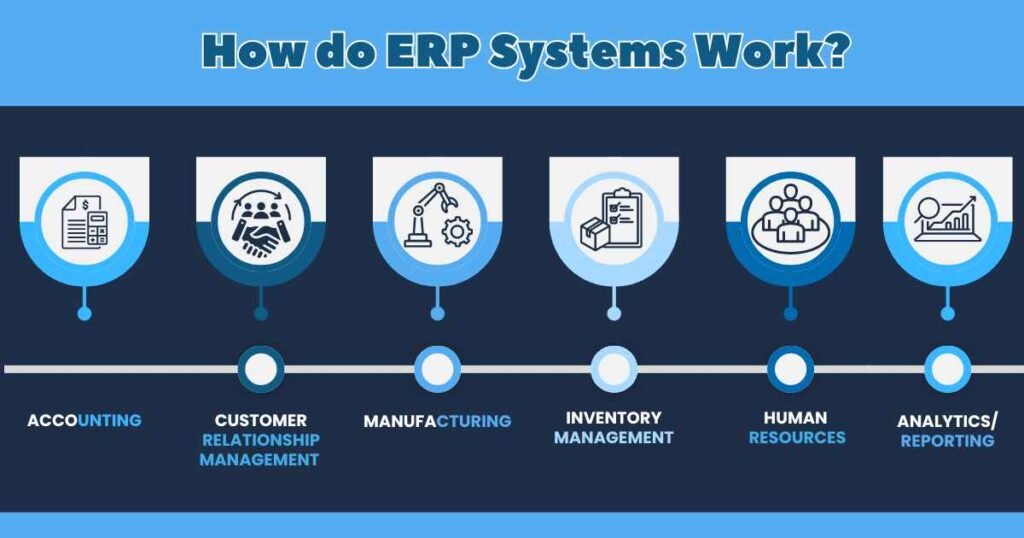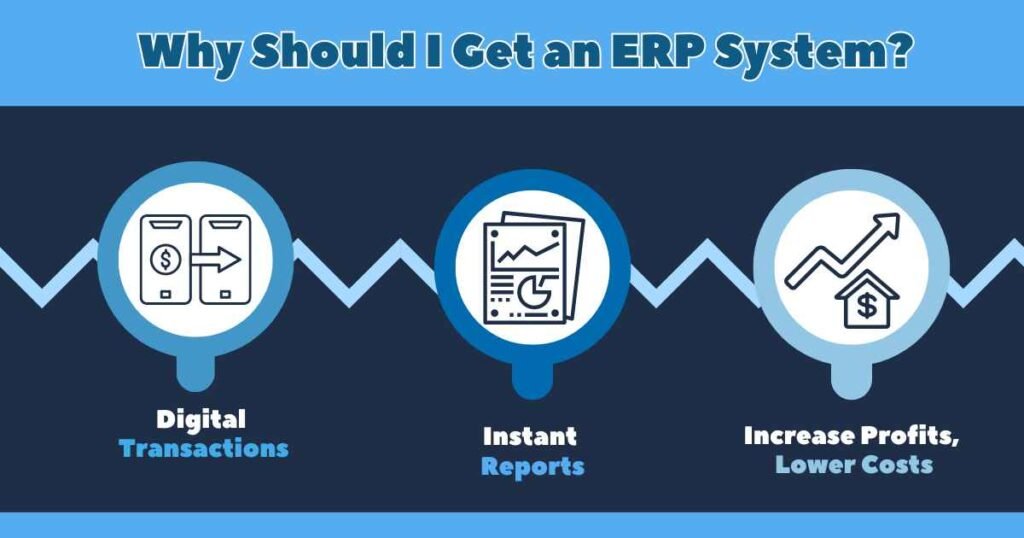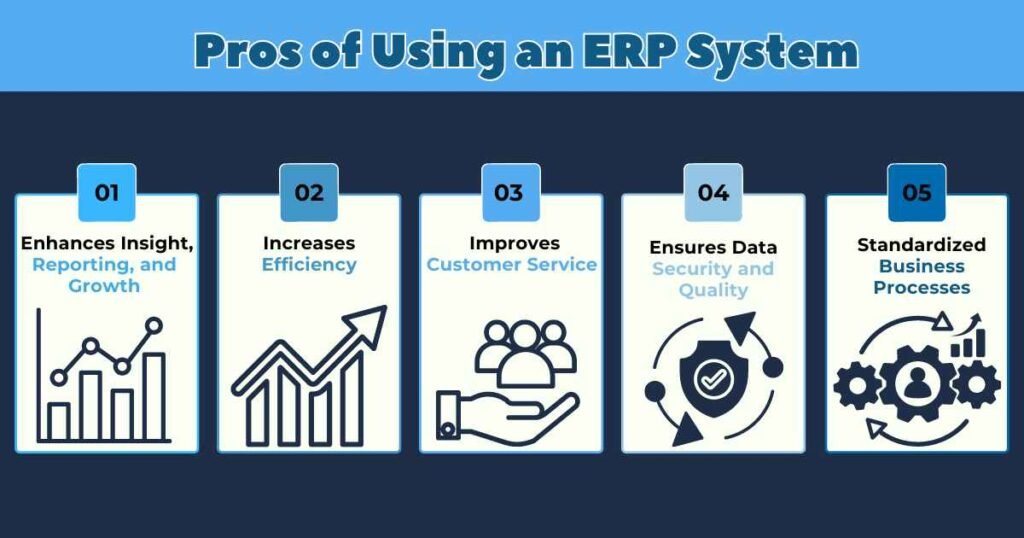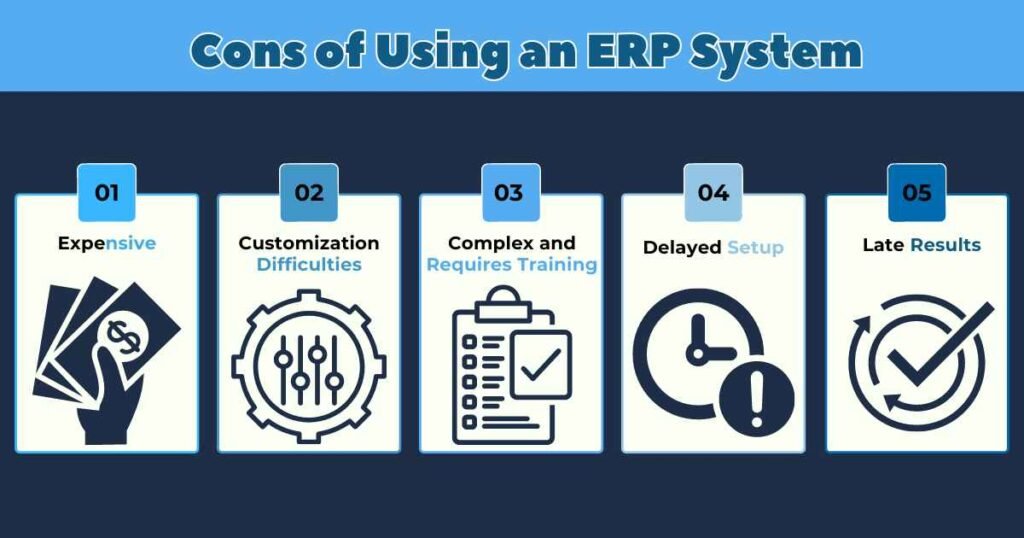Enterprise Resource Planning (ERP) systems have revolutionized modern business operations.
An ERP system integrates and automates key processes like finance, accounting, human resources, supply chain management, and customer relationship management. Its main goal is to provide a unified view of all business activities, enabling better decision-making, increased productivity, and improved efficiency.
According to Panorama Consulting’s 2023 ERP Report, 95% of businesses saw improvements in their processes after using an ERP system. These improvements include smoother operations, less duplication of work, and more automation of manual tasks, which saved time and boosted productivity in various departments.
How do ERP Systems Work?

An Enterprise Resource Planning (ERP) system is software that gathers, analyzes, and shares information from different parts of a company in one place. It organizes the company’s data, automates routine tasks, and simplifies business processes. However, ERP systems have both advantages and disadvantages.
The main goal of an ERP system is to improve operations, save employees time, and enhance communication within the company. ERP software is unique because it helps various departments and can boost revenue and efficiency in areas like:
- Accounting
- Customer Relationship Management (CRM)
- Manufacturing
- Inventory Management
- Human Resources
- Analytics/Reporting
But what about companies with teams spread out in different locations, where the controller is far away? How can they stay coordinated?
The solution is cloud-based software.
Why Should I Get an ERP System?

There are strong reasons to use an ERP system. It helps businesses use data effectively, enabling leaders to manage resources well and improve customer service. This gives the business an advantage and helps it compete better. Here are some benefits for businesses:
- Digital Transactions: Important documents like procurement orders, timesheets, and invoices are stored securely online, making them accessible from anywhere.
- Instant Reports: Finance and business users can quickly gather data from different sources to see how the company is performing. This helps them identify trends, best practices, and areas needing improvement.
- Increase Profits, Lower Costs: With better access to information, sales teams can find new customers, check current prices and product availability, and create contracts more efficiently and accurately. Cloud ERP helps companies by freeing up IT resources from server maintenance and software updates, allowing them to focus on supporting remote employees.
Pros of Using an ERP System

ERP systems are valuable tools for organizations. They help businesses by simplifying operations, protecting information, automating tasks, and creating clear reports. These systems make daily work and future planning more efficient for organizations.
Here are the five pros of using ERP systems:
1. Enhances Insight, Reporting, and Growth
ERP systems provide real-time data access from all departments, improving collaboration and informed decision-making. They help manage inventory and working capital, enhance financial reporting, and offer business intelligence services.
Being modular, businesses can select needed components and deploy them on-premise or in the cloud, ensuring scalability and future growth adaptability.
2. Increases Efficiency
ERP systems increase efficiency by automating repetitive tasks, allowing employees to focus on revenue-generating and strategic activities. Using AI and Machine Learning (ML), they provide smart suggestions and predict trends, helping businesses manage risks and make better decisions.
For example, AI can predict inventory needs based on past sales, ensuring optimal stock levels and reducing costs. ERP systems also automate data entry and processing, reducing errors and speeding up tasks like order processing, invoicing, and financial reporting, resulting in quicker turnaround times and happier customers.
3. Improves Customer Service
With centralized customer information, ERP systems improve customer interactions by providing a complete and up-to-date view of customer data. This allows customer service representatives to quickly access purchase history, preferences, and past interactions, leading to more personalized and efficient service.
ERP systems also support e-commerce integration, enhancing online order processing and customer interactions. Customers can place orders online, track their order status in real time, and receive automatic updates, creating a smooth and satisfying shopping experience.
4. Ensures Data Security and Quality
ERP systems ensure data security by restricting access to authorized users only and using strong authentication and authorization measures to prevent unauthorized access and breaches. Both on-premise and cloud-based ERP systems provide secure data management.
Additionally, ERP systems have audit trails and monitoring features to track data access and changes, allowing quick detection and response to suspicious activities. This ensures the protection, integrity, and confidentiality of critical and sensitive information.
5. Standardized Business Processes
ERP systems standardize processes, ensuring consistency and reliability. They create uniform procedures, making training easier and reducing errors through automation. This leads to more accurate data, lower costs, and increased efficiency.
ERP systems also save money by reducing labor costs and inefficiencies. They improve coordination and communication between departments with a unified information-sharing platform, allowing all teams to access up-to-date data and collaborate better.
Cons of Using an ERP System

ERP systems offer many benefits, but it’s also important to understand the potential downsides. Here are some of the main disadvantages:
1. Expensive
Traditional ERP systems like SAP Business One can be very costly, often requiring tens of thousands of dollars for a single license. This high initial expense can be a major obstacle, especially for small to medium-sized businesses.
More affordable options include cloud-based solutions with monthly subscriptions or open-source ERP software, which have lower starting costs and flexible payment plans. Cloud-based ERP systems also offer scalability and reduce the need for large IT infrastructure investments.
2. Customization Difficulties
While customizing ERP software can be beneficial, it can also be expensive and complicated. It requires time, expertise, and resources. Many businesses underestimate these needs, resulting in incomplete customization or going over budget. Excessive customization can also make future upgrades difficult.
Additionally, highly customized systems may rely on specific setups, increasing the risk of operational issues if not managed well. This can also make it harder to adopt new features and improvements in future ERP updates.
3. Complex and Requires Training
ERP systems have many features, which can make them complex and hard to use. Without good planning for setup and training, businesses might not get a good return on investment. Some companies might find ERP systems too complicated and have trouble getting their team to use the software.
Training based on roles and picking systems with only the needed features can help solve these problems. Also, ongoing support and clear communication about the benefits can make the switch easier. Involving employees in the setup process can also increase their buy-in and reduce resistance to change.
4. Delayed Setup
Implementing a new ERP system can take a long time, sometimes up to two years, especially if the hardware is old. Careful planning is needed to avoid disrupting business operations. After the system is in place, users need time to learn how to use it, and the learning process can be slow.
Companies must invest in thorough training and support to help users get comfortable with the system. Regular maintenance and updates are also necessary to keep the ERP system working well.
5. Late Results
Implementing, training, and adapting to an ERP system takes time and patience. You won’t see immediate results, and it may take months to see a return on investment. Like building a city, success with ERP takes time and dedication.
It’s also important to set realistic goals and milestones to track progress. Regular evaluation and adjustments help ensure the ERP system continues to meet business needs over time.
Final Thoughts
While ERP systems provide many benefits, it’s important to also consider their downsides and plan carefully for a successful implementation. When selecting the right platform for your business, it’s important to weigh the pros and cons of ERP software. Don’t be put off by the potential drawbacks; these tools can significantly enhance your business.
For most companies, the advantages of ERP systems usually outweigh the disadvantages. The potential for more efficient operations and increased productivity over time makes the investment in ERP systems worthwhile.
FAQs
What is ERP?
ERP systems enhance efficiency by automating tasks and streamlining processes, reducing manual work and errors. They improve data accuracy and provide real-time access to information, aiding better decision-making. Additionally, ERP systems facilitate better collaboration by centralizing data, making it easier for teams to share information. They are also scalable, allowing businesses to add new features as needed. However, it’s important to consider the pros and cons of ERP systems before implementation to ensure they meet your business needs and offer a good return on investment.
What are some common drawbacks of implementing an ERP system?
The main drawbacks of ERP systems include high initial costs for software, hardware, and training. The implementation process can be lengthy and complex, disrupting regular operations. Employees may resist the new system, requiring extensive training. Ongoing maintenance and upgrades add to the overall cost and complexity. These issues highlight the Pros and Cons of ERP, where the benefits of improved efficiency must be weighed against these significant challenges.
How does an ERP system affect data management and reporting?
ERP systems improve data management and reporting by centralizing information, ensuring consistency and accuracy. This allows businesses to generate up-to-date reports and gain valuable insights. Real-time data access helps in tracking performance and making informed decisions. However, when considering the pros and cons of ERP, it is essential to note that proper planning and training are crucial to fully utilize these benefits.
What should businesses think about before starting an ERP system?
Before implementing an ERP system, businesses should conduct a cost-benefit analysis to understand the investment and potential ROI. When considering the pros and cons of ERP, planning is important to minimize disruptions during implementation. Comprehensive training and support for employees are needed to manage the learning curve. Additionally, choosing an ERP system that fits the business’s needs and can be scaled and customized is vital. Regular evaluation ensures the system continues to meet the organization’s needs.
